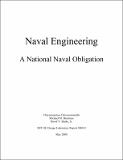Naval Engineering A National Naval Obligation
Author(s)
Chryssostomidis, Chryssostomos; Bernitsas, Michael; Burke, David
Downloadfinal_report_may_16_00.pdf (709.1Kb)
Metadata
Show full item recordAbstract
As part of its national obligations, ONR must ensure US world leadership in those unique technology areas that insure naval superiority. ONR accomplishes this mission through research, recruitment and education, maintaining an adequate base of talent, and sustaining critical infrastructure for research and experimentation. One critical area requiring support by ONR is the "knowledge infrastructure" in Naval Architecture and Marine Engineering. An innovative knowledge infrastructure in NA & ME consists of two main elements:
• People who have the knowledge, skills and experience to perform innovative design and engineering applied to in Naval Architecture and Marine Engineering; and
• An industry that employs these people and allows this innovative knowledge to be applied in the ships it designs and builds for the Navy.
The universities along with industry develop the technology and educate the people who are employed by industry. In turn, the research supported primarily by the government provides direct support for the conduct of research and the education of the future faculty who perform their doctoral research in this discipline.
This study examined the current situation in navy related Naval Architecture and Marine Engineering. The need for ONR support in this area is identified and recommendations made to establish long term support that will provide for the introduction of innovative technology in naval ships. The following are documented in this report to establish this need:
(1) The uniqueness of "Engineering for the Marine Environment" is explained. Naval Architecture and Marine Engineering, among all engineering disciplines, studies the design of complex marine systems and their performance in the marine environment. The latter is stochastic in nature and exerts motion and vibration dependent loads.
(2) The uniqueness of analysis, design, and manufacture of naval ships is presented. A key unique aspect of naval ship design is the need for new capabilities in performance such as high speed while remaining affordable.
(3) A vision of the role and knowledge of the NA&ME professional of the future is presented. In a distributed simulation based environment, naval architects will lead the design effort by contributing the expertise in marine mechanics, design of complex marine systems, and design for manufacturing. Naval Architects are trained in marine mechanics and the design of complex marine systems. This breadth of skills will be even broader in the future while remaining base on experience in designing naval ships.
(4) The Navy need for a solid national knowledge infrastructure in NA&ME is established. Accordingly, the need for ONR support of research and education in the few healthy NA&ME Departments remaining in top tier US universities is very strong.
(5) Navy needs for breakthroughs in such areas as survivability of structures, stealth and hydrodynamic performance, and adaptive structures are identified. From those, fundamental research that naval architects are uniquely qualified to perform for ONR is specified.
(6) A selective industry survey has established the areas of technical expertise needed. Naval Architecture and Integrated Ship Design and Shipbuilding and Manufacturing Technology top the list.
(7) Freshmen in engineering, the few universities remaining active in teaching and research in NA&ME, ONR, and the shipbuilding industry are the parties involved in this problem. The challenges each party faces are discussed.
(8) The urgency for ONR to help preserve the knowledge infrastructure in NA&ME is assessed based on current national trends in funding and student choices.
(9) An educated estimate of the national need for naval architects is presented and used as a basis for establishing the level of long term funding in research and education required for a steadily healthy and competitive higher education environment.
(10) An implementation plan for a vigorous knowledge infrastructure and a healthy university environment is proposed. This plan abides by the ONR mandate of supporting fundamental, high risk, innovative research needed by the Navy. It calls for:
• A research program centered on National Challenge Initiatives with the intent to revolutionize the state of the art in ship analysis and design and to bring the participants, industry, government and academia, in this endeavor closer together in perspective and time for innovation.
• Acknowledging NA&ME as a specialty area of basic research. This is typically done by federal research funding agencies. As an example, in NSF, mechanical, civil, electrical, chemical, etc. are established specialty areas.
• Modernization of contents and methods of delivery of marine curricula.
• Industrial participation in both research and education activities.
Date issued
2000-05-16Series/Report no.
Design Lab Report;2000-9
Keywords
National Naval Resposibility, Naval Engineering, Education, Ocean Engineering, Naval Architecture and Marine Engineering, NNR
Collections
Related items
Showing items related by title, author, creator and subject.
-
13.400 Introduction to Naval Architecture, Fall 2004
Herbein, David; McCoy, Timothy J. (Timothy John) (2004-12)Introduction to principles of naval architecture, ship geometry, hydrostatics, calculation and drawing of curves of form, intact and damaged stability, hull structure strength calculations and ship resistance. Projects ... -
2.701 Introduction to Naval Architecture (13.400), Fall 2004
Herbein, David; McCoy, Timothy (2004-12)This course is an introduction to principles of naval architecture, ship geometry, hydrostatics, calculation and drawing of curves of form. It also explores concepts of intact and damaged stability, hull structure ...